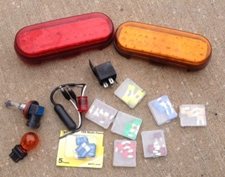All trucks, truck tractors, and busses (except those towed in drive away tow away operations) must be equipped with the following, according to Code of Federal Regulations (CFR) Title 49, Part 393.95. Fire Extinguishers, Spare Fuses, and Warning Devices for stopped vehicles. There are some restrictions and requirements for the warning devices we will discuss later.
There are minimum ratings for the fire extinguishers depending upon whether you are hauling HAZMAT or not. For those who do haul HAZMAT in quantities that require placarding, your fire extinguisher must have an Underwriters' Laboratories (UL) rating of 10 B: C or more. Those who don't haul hazmat have a choice, either one (1) fire extinguisher with a UL rating of 5 B: C or more; or two (2) fire extinguishers with a UL rating of 4 B: C or more.
Each fire extinguisher must be labeled or marked by the manufacturer with its UL rating. It must be designed, constructed, and maintained so that it can be determined if it is fully charged. The extinguisher must be mounted in a location that is readily accessible if needed yet not be rolling or sliding around. Laying the fire extinguisher between two wrenches is not properly secured. The extinguisher must use an extinguishing agent that does not need freeze protection and is complying with toxicity provisions of the EPA's Significant New Alternatives Policy regulations under 40 CFR part 82, subpart G.

Whew, wasn't that exciting? It doesn't get much better from here on but it is good information. Spare Fuses are something I would say most drivers don't carry, but it is required that you do. When I drove for a major carries they didn't supply us with them and when I asked for them I was told " if you find yourself in a situation that you need them, we will get you some then ". As a result I have always had a small kit that has fuses of all sizes, some relays that fit the truck I’m in, and at least one bulb of every type on the vehicle, truck or trailer, including headlamp bulbs. If there is a hard to find lamp or odd one I try to carry two.
Back to fuses, it says in the regulations, Power units for which fuses are needed to operate any required part or accessory must carry one spare fuse for each type and size of fuse needed to operate those parts or accessories.
Warning devices for stopped vehicles, there is fire involved here, (in some cases) what fun. Other than the restrictions in paragraph g, one of the following options must be used. Three bidirectional emergency reflective triangles that conform to FMVSS No.125, #571.125. Those are those things in that long thin red plastic box that is always in you way. or 2, At least 6 fuses or 3 liquid burning (see I told you there was fire involved) flares. You are not limited to that number of fuses as long as they satisfy the requirements of #392.22. 3, other warning devices may be used in addition to, but not instead of the required warning devices, provided these do not decrease the effectiveness of the required devices.

So the restrictions are on the flame producing (more fire) devices. If you carry 1.1, 1.2, 1.3 explosives, any cargo tank carrying 2.1 flammable gas or class 3 flammable liquid, or any CMV using compressed gas as a fuel cannot carry, liquid burning flares, fusses, oil lanterns, or any signal produced by a flame. You cannot carry these much less use them, but it makes sense, fire, things that go boom and things that burn by their own nature and design, should not be used together.
Requirements for fusses and liquid burning flares. Fusses must burn for at least 30 minutes each, and liquid-burning flares must hold enough fuel to burn at least 60 minutes. Each should be marked with the UL symbol and conform to UL No.912, Highway Emergency Signals, fourth edition,7-30-1979.
Requirements for red flags. They shall not be less than 12 inches square, with stands that will maintain them in an upright position, flags seem to be as boring as you can get as far as warning equipment goes.
The regulations are full of extra words that I didn't feel the need to retype, but if you want a good read to put you to sleep, I recommend this book, Federal Motor Carrier Safety Regulations. It is a snoozer, but full of information that you are required to know. That is a summary of Emergency Equipment, as I understand it, requirements and restrictions. FMCSR, CFR Title 49, Part 393.95, Subpart H - Emergency Equipment, is where all the above information came from, however I did add some of my own quips, left out some of the goop and reworded some of it to help with digestion. Hope you learned something, as I know I did.